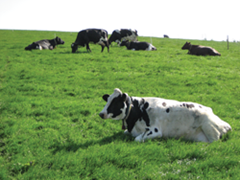Food and drink’s bright future
 Worth almost €6 billion in export sales, Irish agri-food exports are playing a strong role in recovery with hopes of doubling sales by 2020.
Worth almost €6 billion in export sales, Irish agri-food exports are playing a strong role in recovery with hopes of doubling sales by 2020.
Total Irish agricultural output rose from €5.03 billion in 2005 to €5.81 billion in 2008 before dropping to €4.72 billion the following year. It has since undergone a marked recovery, to reach €6.24 billion last year.
Agricultural exports in 2011 totalled an unprecedented €5.86 billion: 93.9 per cent of Irish farm produce. Export trends have followed those for output over recent years. As explained (see pages 48-49), 46.8 per cent of exports in 2011 went to Great Britain and Northern Ireland. Another 38.8 per cent went to the rest of the EU and the remaining 14.4 were exported elsewhere.
The trends since 2010 (see table) have been continued dominance by the UK market, recovering trade with other European partners and rising sales to the rest of the world.
When all foodstuffs are included, the total export figure for 2011 rises to
€7.85 billion, with the main sub-sectors as follows:
• meat and meat preparations (€2.76 billion);
• dairy products and eggs (€1.78 billion);
• fish, crustaceans and molluscs (€416.7 million); and
• live animals (€353.6 million).
In addition, beverages (mainly alcoholic) generated €1.09 billion in 2011. Just over half of beverage exports (55.7 per cent) went to the EU. The USA accounted for 28 per cent (€304.3 million) and Britain 22.9 per cent (€248.7 million).
Meat, dairy and poultry products tend to attract the most customers in neighbouring countries where they can shipped in quickly and sold fresh.
Beef dominates the meat trade. 43.5 per cent of meat exports were sold in Britain followed, at some distance, by France (11.1 per cent) and Italy (9 per cent). With 92.8 per cent of all meat exports within the EU, other export markets make up very small percentage shares. China leads with 1.6 per cent: €26.9 million on the mainland and an extra €17.4 million when Hong Kong is included.
However, the EU and British shares of dairy and egg exports were smaller:
81.0 per cent and 37.4 per cent respectively. Two per cent were sold in the USA (€36.3 million), followed by Algeria (€35 million) and China (€29.7 million).
Likewise, the EU bought 79.1 per cent of Irish marine foods, including 28.8 per cent in France and 14.6 per cent in Spain. Britain, by comparison, had an 8.9 per cent share (€37 million). Nigeria, with 6 per cent and £24.8 million, was the largest non-EU market.
Half of live animal exports (50.3 per cent) went to Great Britain and another 11.9 per cent to Northern Ireland. Italy (14.1 per cent) was the largest continental European partner.
The Food Harvest 2020 strategy aims to raise export levels to €12 billion by 2020, thus contributing to the State’s economic recovery. Going forward, the strategy anticipates that continental Europe will overtake the UK, provided that a common currency survives.
Since taking office, Agriculture Minister Simon Coveney has focused on building up support for CAP reform (among fellow EU ministers) and has visited China, Algeria and the USA on trade missions. Ireland’s Presidency of the Council of the EU from January to June next year is guaranteed to give the State a major platform on which it can promote its growing agri-food sector.
| Agriculture Exports (€ billion) | 2010 | 2011 |
| UK | 2.38 | 2.74 |
| Rest of EU | 1.96 | 2.27 |
| Rest of world | 0.6 | 0.84 |
| Total | 4.94 | 5.86 |





